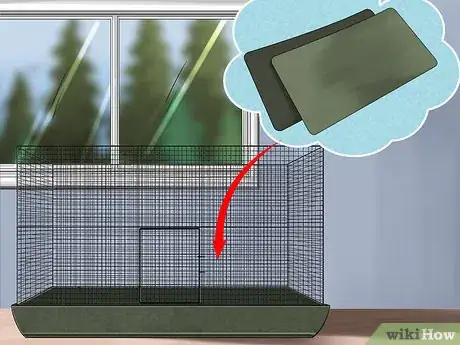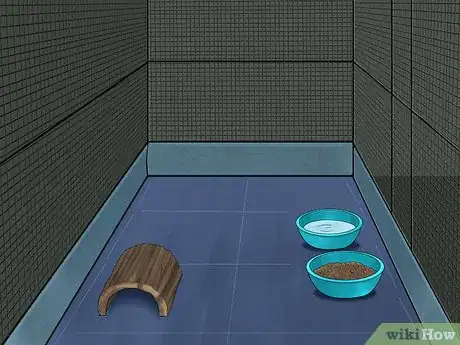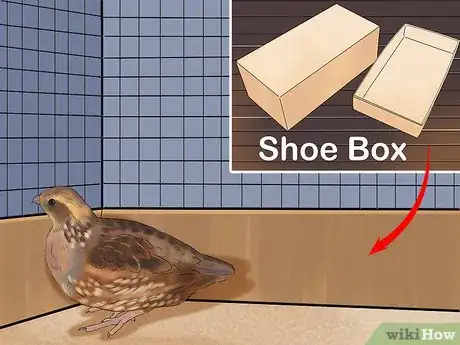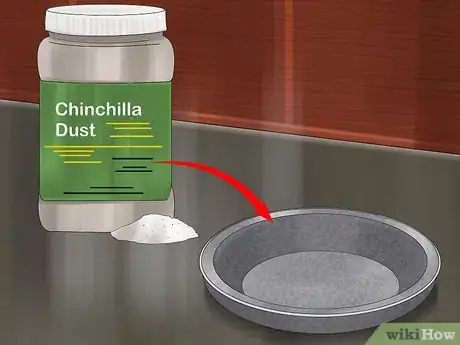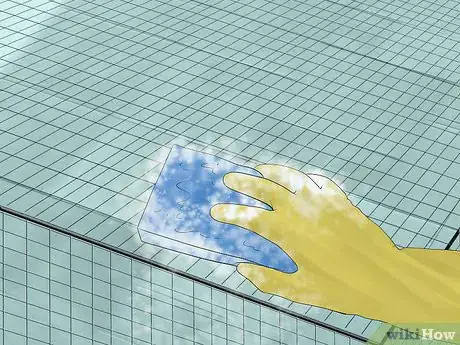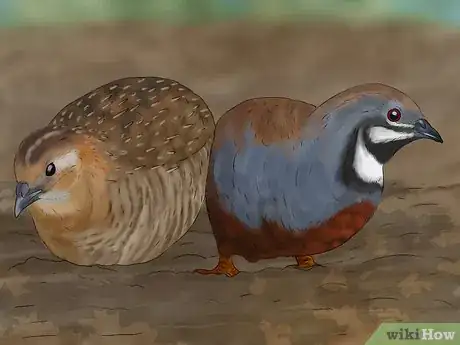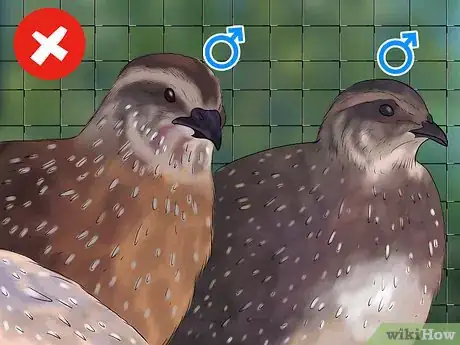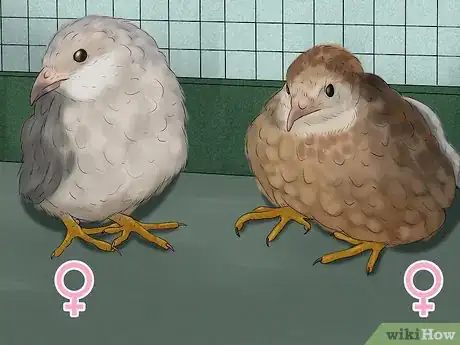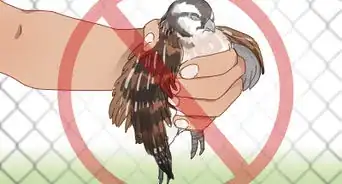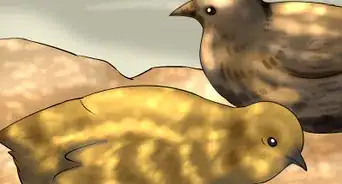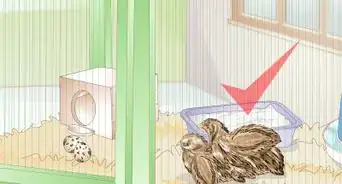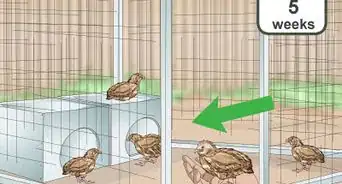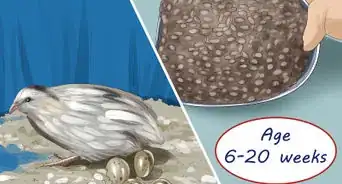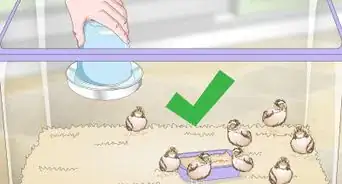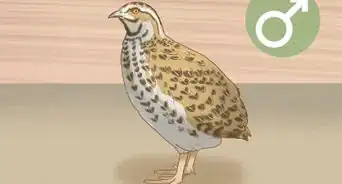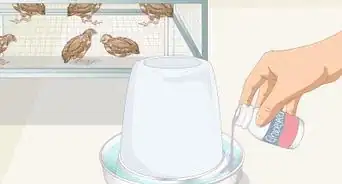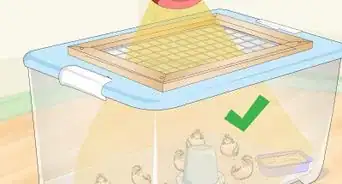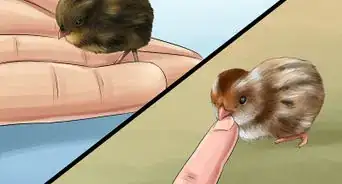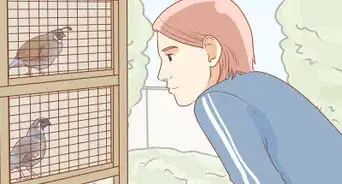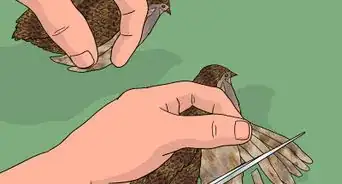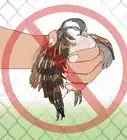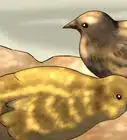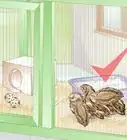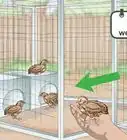This article was co-authored by Pippa Elliott, MRCVS. Dr. Elliott, BVMS, MRCVS is a veterinarian with over 30 years of experience in veterinary surgery and companion animal practice. She graduated from the University of Glasgow in 1987 with a degree in veterinary medicine and surgery. She has worked at the same animal clinic in her hometown for over 20 years.
This article has been viewed 27,859 times.
Button quails, also known as Chinese painted quails, are small birds that make great pets. They are easily tamed and have a small size that makes them ideal for life in aviaries. However, when keeping multiple button quails you need to make some accommodations. If you keep them divided by sex and give them enough space, they can live long and healthy lives with you.[1]
Steps
Providing for the Basic Needs of Your Birds
-
1Provide a spacious habitat. Button quails need room to move around. Ideally, they would be kept in an aviary where they would have room to run around the ground. However, as long as each bird has about eight cubic feet of space to run around in, that should be sufficient.
- The bird's cage does not need to be very tall because they stay on the ground.
-
2Make sure your bird has solid floors to stand on. A button quail habitat needs to have solid floors, as the button quail's feet are not designed for perching. Wire floors will hurt their feet, so this is very important.
- You typically can customize any bird cage to have a solid floor by inserting rubber mats on the bottom of it. This will be comfortable for the bird to walk on and it is easily cleaned.[2]
- A button quail will quickly soil any floor that you install. Choose a type of flooring that will be easy for you to clean. You might want to get a cage where the floor slides out.
Advertisement -
3Supply food and water on the floor of the cage. Because button quails spend most of their time on the ground, you will need to place their food and water dishes there as well. This will allow the birds easy access to the nutrients they need, which typically includes game-bird diet that is high in animal protein and fresh vegetables and fruit.[3]
- Food and water should be replaced daily and all dishes should be cleaned before being used again. This will help keep your birds healthy and disease free.
- Every button quail does not need its own food and water dishes. As long your birds can access food and water easily at most times, one dish of each will be fine.
-
4Provide places for the birds to hide. Button quails like to have a safe place to hide in their cages. This can be an upside-down shoe box, or some other container, with a door or two cut in it.[4]
- Giving your birds a place to hide will help them to feel safe and secure in their home.
-
5Give the birds grooming dust. Like many birds, button quails often use dust to clean themselves. Giving them a shallow bowl of chinchilla dust or another dust bathing product will allow them to do this effectively.[5]
- The container you provide the dust in should be big enough for the bird to completely sit and move around in.
- Even if you have multiple birds in your cage, one dust bath will suffice.
-
6Keep the cage clean. Button quail spend most of their time at the bottom of their cage. This means that you should clean the bottom of the cage daily, so that it stays clean. You should also clean all other items in their cage, such as food and water dishes, on a daily basis.
- Cleaning a button quail cage daily will minimize the risk of your birds developing disease.
-
7Keep the birds relatively warm. Button quail are native to the warm grasslands of China, and thus do not thrive in cold or extremely hot temperatures. Keep them at around average household, trying not to exceed 80°F (27°C).[6]
- If you have an outdoor cage, make sure it is protected from extreme temperatures. Have it under a covered area, protected from the wind, and make sure it is heated if temperatures drop. Outdoor cages might also attract vermin, like rats.
Making Accommodations for Multiple Birds
-
1House male and female pairs of birds together. In the wild, button quails form monogamous pairs and do not live in colonies. With this in mind, it is probably best to keep them housed as male and female pairs.
- These pairs will likely reproduce, however, so chicks will be added to the pairs for periods of time.
- If you want to breed quails, keep about 1 male for every 5 females. This will reduce fighting.[7]
-
2Keep males away from each other. Male button quail can be quite territorial and aggressive towards each other, so they should be kept in separate cages. If they are housed together they may eventually attack each other, which can lead to fatalities.
-
3Put female button quails together, if necessary. If you need to keep more than a male and female pair of button quails in the same cage, you can keep females together. They can be territorial at times but are not likely to fight heavily or injure each other.[8]
- There can be one male included in a cage with all females, as it will not be territorial toward females.[9]
References
- ↑ https://www.beautyofbirds.com/buttonquails.html
- ↑ http://www.cspotsfarm.com/quailhousing.html
- ↑ https://www.beautyofbirds.com/buttonquails.html
- ↑ https://www.beautyofbirds.com/buttonquails.html
- ↑ https://www.petco.com/content/petco/PetcoStore/en_US/pet-services/resource-center/caresheets/button-quail.html#
- ↑ http://mycccbc.org/files/8_Types_of_bird_Care_Sheets.pdf
- ↑ https://poultrykeeper.com/general-quail/breeding-quail/
- ↑ https://www.beautyofbirds.com/buttonquails.html
- ↑ http://mycccbc.org/files/8_Types_of_bird_Care_Sheets.pdf
About This Article
To keep multiple button quail, house them in large cages so they can run around on the ground. Make sure the floors are made from solid material, like rubber, since quail feet are not made for perching. You should also place food and water dishes on the ground, which is where quail spend most of their time. Additionally, house male and female pairs together, since quail form monogamous pairs in the wild. Alternatively, keep a male with multiple females to avoid males getting territorial and fighting with each other. If you have multiple unpaired males, house them in separate cages so they don't fight with each other. For tips from our Veterinary co-author on how to breed your quail, read on!

